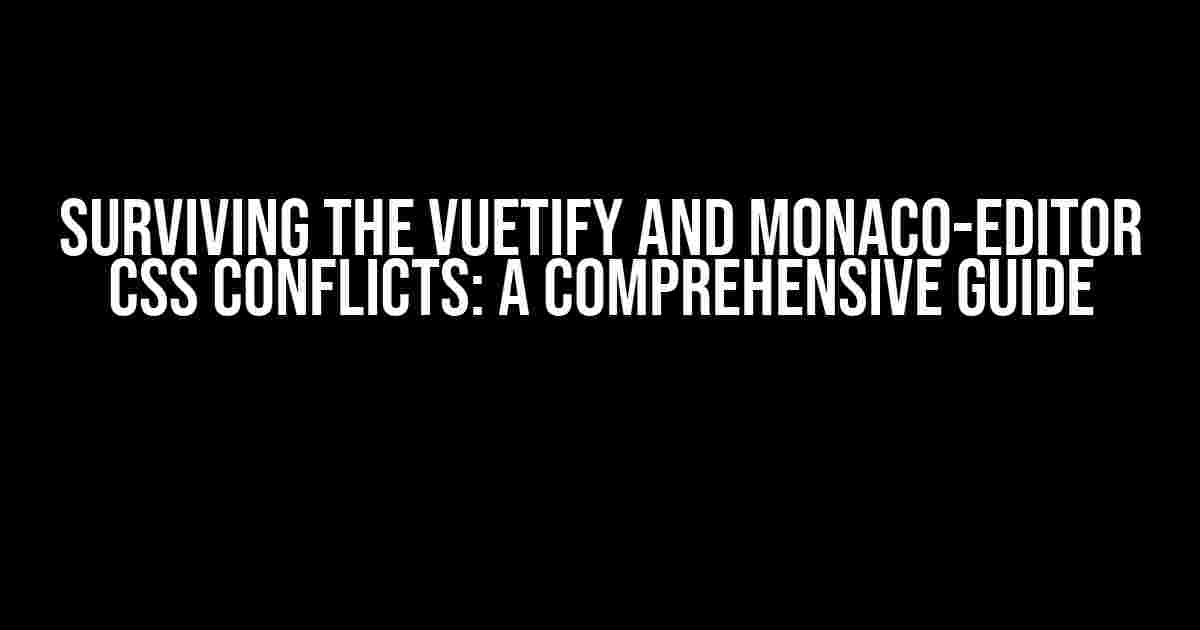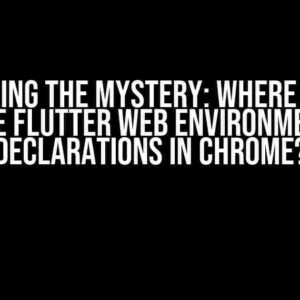Are you tired of dealing with the pesky CSS conflicts between Vuetify and Monaco-Editor? You’re not alone! In this article, we’ll delve into the world of CSS conflicts and provide you with a step-by-step guide on how to overcome them. Buckle up, and let’s dive in!
What are CSS Conflicts?
CSS conflicts occur when two or more CSS files or frameworks clash, resulting in unexpected styling or layout issues. In the case of Vuetify and Monaco-Editor, these conflicts can be particularly frustrating, as both libraries have their own robust set of CSS rules.
Understanding the Conflict: Vuetify vs. Monaco-Editor
Vuetify is a popular Vue.js framework that provides a comprehensive set of UI components and a robust grid system. Monaco-Editor, on the other hand, is a powerful code editor that provides an exceptional coding experience. When used together, these two libraries can create a styling nightmare.
The Root of the Problem: CSS Scope and Specificity
The issue lies in the way both Vuetify and Monaco-Editor apply their CSS styles. Vuetify uses a scoped CSS approach, which means that its styles are isolated to the component level. Monaco-Editor, however, uses a more traditional, global CSS approach. This disparate approach to CSS scoping creates conflicts when both libraries are used together.
Symptoms of CSS Conflicts: What to Look Out For
Here are some common symptoms of CSS conflicts between Vuetify and Monaco-Editor:
- Unstyled or misstyled Monaco-Editor components
- Incorrect spacing, padding, or margin issues
- Discrepancies in font sizes, families, or colors
- Inconsistent or missing borders, backgrounds, or outlines
Resolving CSS Conflicts: Strategies and Solutions
Now that we’ve identified the root of the problem and recognized the symptoms, it’s time to dive into the solutions. Here are some strategies to help you overcome the CSS conflicts between Vuetify and Monaco-Editor:
1. Use CSS Scopes
One effective way to resolve CSS conflicts is to use CSS scopes. Vuetify provides a built-in feature called `scoped` that allows you to scope your CSS styles to a specific component. By using `scoped` with your Vuetify components, you can isolate their styles and prevent them from affecting Monaco-Editor.
<style scoped>
/* Your scoped CSS styles here */
</style>2. Utilize the `monaco-editor` Class
Monaco-Editor provides a default class called `monaco-editor` that you can use to target its components. By adding this class to your Monaco-Editor instance, you can apply custom styles that won’t conflict with Vuetify.
<div class="monaco-editor">
<!-- Your Monaco-Editor instance here -->
</div>3. Override Monaco-Editor Styles
Sometimes, you may need to override Monaco-Editor’s default styles to ensure they play nicely with Vuetify. You can do this by creating custom CSS rules that target Monaco-Editor’s components.
.monaco-editor {
/* Override Monaco-Editor styles here */
font-size: 16px;
font-family: Monaco, monospace;
}4. Use CSS Preprocessors like Sass or Less
CSS preprocessors like Sass or Less can help you write more modular and maintainable CSS code. By using a preprocessor, you can create separate CSS files for Vuetify and Monaco-Editor, reducing the likelihood of conflicts.
// vuetify-styles.scss
.v-application {
/* Vuetify styles here */
}// monaco-editor-styles.scss
.monaco-editor {
/* Monaco-Editor styles here */
}5. Leverage the Power of CSS Variables
CSS variables (also known as custom properties) allow you to define reusable styles that can be accessed throughout your application. By using CSS variables, you can create a shared style language between Vuetify and Monaco-Editor.
:root {
--primary-color: #1976d2;
--secondary-color: #42b983;
}.v-application {
background-color: var(--primary-color);
}.monaco-editor {
background-color: var(--secondary-color);
}Best Practices for Avoiding CSS Conflicts
To avoid CSS conflicts between Vuetify and Monaco-Editor altogether, follow these best practices:
- Use a consistent naming convention for your CSS classes and IDs.
- Keep your CSS code organized and modular.
- Avoid using `!important` in your CSS rules.
- Test your application thoroughly to catch conflicts early.
- Use a CSS linter or formatter to ensure consistency.
Conclusion
Surviving the Vuetify and Monaco-Editor CSS conflicts requires a combination of understanding, strategy, and best practices. By using CSS scopes, targeting specific classes, overriding styles, leveraging CSS preprocessors, and utilizing CSS variables, you can overcome the styling challenges that arise when using these two powerful libraries together. Remember to follow best practices, test thoroughly, and stay vigilant to ensure a conflict-free development experience.
| Strategy | Description |
|---|---|
| CSS Scopes | Use Vuetify’s `scoped` feature to isolate component styles. |
| `monaco-editor` Class | Target Monaco-Editor components using the `monaco-editor` class. |
| Override Styles | Create custom CSS rules to override Monaco-Editor’s default styles. |
| CSS Preprocessors | Use Sass or Less to write modular and maintainable CSS code. |
| CSS Variables | Define reusable styles using CSS variables. |
Now, go forth and conquer those CSS conflicts!
Frequently Asked Question
Got stuck with Vuetify and Monaco-editor CSS conflicts? Worry not! We’ve got you covered. Check out these frequently asked questions to resolve those pesky styling issues.
What causes CSS conflicts between Vuetify and Monaco-editor?
The main culprit behind CSS conflicts between Vuetify and Monaco-editor is the competing global styles. Both libraries use global CSS selectors, which can lead to unintended styling override. Additionally, Monaco-editor uses iframe to render the editor, which can also cause styling issues.
How do I scope Monaco-editor styles to avoid conflicts with Vuetify?
One solution is to wrap the Monaco-editor component in a container element and scope the styles using CSS classes. You can add a unique class to the container element and use that class to target the Monaco-editor styles. This way, you can avoid global styles overriding Vuetify’s styles.
Can I use CSS preprocessors like Sass or Less to avoid conflicts?
Yes, you can! CSS preprocessors like Sass or Less can help you namespace your styles and avoid conflicts. By using a preprocessor, you can define a unique namespace for your Monaco-editor styles, which won’t clash with Vuetify’s global styles.
What if I’m using Vuetify’s pre-defined components and still facing conflicts?
In this case, you can try using Vuetify’s built-in utility classes to customize the styles of your components. For example, you can use Vuetify’s `class` prop to add custom classes to your components and override the conflicting styles. Additionally, you can also use Vuetify’s `deep` selector to target the Monaco-editor component and apply custom styles.
Are there any community-driven solutions for Vuetify and Monaco-editor integration?
Yes, there are! The Vue.js and Vuetify communities have created several plugins and libraries to simplify the integration of Monaco-editor with Vuetify. These libraries provide pre-built components and configurations to help you avoid CSS conflicts and get started quickly. Be sure to check out these resources to find the best solution for your project.






